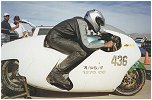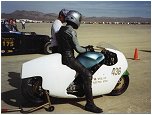![]()
![]()
El Mirage Dry Lake Bed
November, 2002
(click photo for the big version)
| El Mirage is an ancient dry lake bed ..... ....(that still floods once in a while) that's about an hour's drive northeast of Los Angeles. It's federal land, open to all, and the racers have had a course set up there for land speed racing for over 60 or 70 years. The course is laid out on the flat dry baked-mud surface. It's about 1 1/3 miles from start line to the timing lights, and another mile or so of course for vehicles to slow down. The course, being dried mud, can be dusty -- so much that sometimes racers have to wait a few minutes after one run before the next can be made -- waiting for the dust to settle down. Or, if it's windy, the dust can blow up and obscure vision within seconds. For instance, I made three runs the weekend we were at EM. The second one started out okay, and about half-way down the course -- I was going about 150 at the time -- a gust of wind blew up a big cloud of dust, and I couldn't see more than about fifty feet. This can be, you'll no doubt understand, a disconcerting experience! I rolled out of the throttle a little bit and sat up to try to get my bearings -- and then the dust cleared and I could see the finish line only a few hundred yards away, with the timing light apparatus right in front of me. I had time to think two things: One, that Glen Barrett, the chief timer, was gonna be really cranky with me if I hit his timing lights; and Two, that if I wanted a decent speed for the run that I'd best get back into the throttle NOW. I did -- and my speed for that run was measured to be in the mid-150s. I made one more run that weekend, and it was my fastest. So now I can claim, legitimately, that' I've driven 175 miles per hour down a dirt road. |
|
I sat in this "tuck" position and had Nancy take the photo so we could see exactly where the windscreen and my helmet met. We took some measurements, too -- and sent all of the information (photo, too) to Leif Gustafsson at Gustafsson Plastics in St. Augustine, Florida, so he could make a windscreen that helped move the air up and over my helmet better than this "stock" screen did. The new one is a few inches taller and sure engouh, there's much less turbulence behind it -- and that means there's that much less wind resistance to slow me down. |
|
I ordered the bodywork from AirTech, Kent Riches' company in suburban San Diego. When he shipped it to Marquette I realised that I wasn't the right guy to try to make it fit -- so the bike and Nancy and I went to San Diego for a nice little vacation. We had been at Bonneville for a meet there, anyway, so it was only another few thousand miles to go home via SD, California. Kent worked on the fiberglass and Randy Nelson (of MDR Racing) made up the mounts to hold the body on the bike) and the body is now solidly mounted. It takes about fifteen minutes to install or remove the entire three-piece body. The basic body is, as you can see, white fiberglass, and these are the only photos of it while still white. Look elsewhere around this site and you'll see the coloring that Rachel and Steve Niemi painted on it later on. . . |
|
| I'm sitting on the bike, with the rear stand still in place, at the start line at El Mirage. Monte Warnock is the guy standing sort of hidden behind me. He's the guy that keeps the waiting lines moving, in order, and makes sure each racer is ready well before it's his turn to go down the course. Let's see -- oh, yeah, the rear stand. Most race bikes have no kick stand. They're removed to save weight, or to allow increased ground clearance, or because they just won't fit with the custom bodywork. So there's a firm called "Pit Bull" (other companies, too) that make stands that hold up the back or the front of a bike, whether to allow the rider (like me, here) to NOT have to hold the bike upright while waiting, or to allow the wheel to be up in the air for maintenance or adjustments, and so on. We've got three or four different Pit Bull stands for our fleet of bikes. | |


